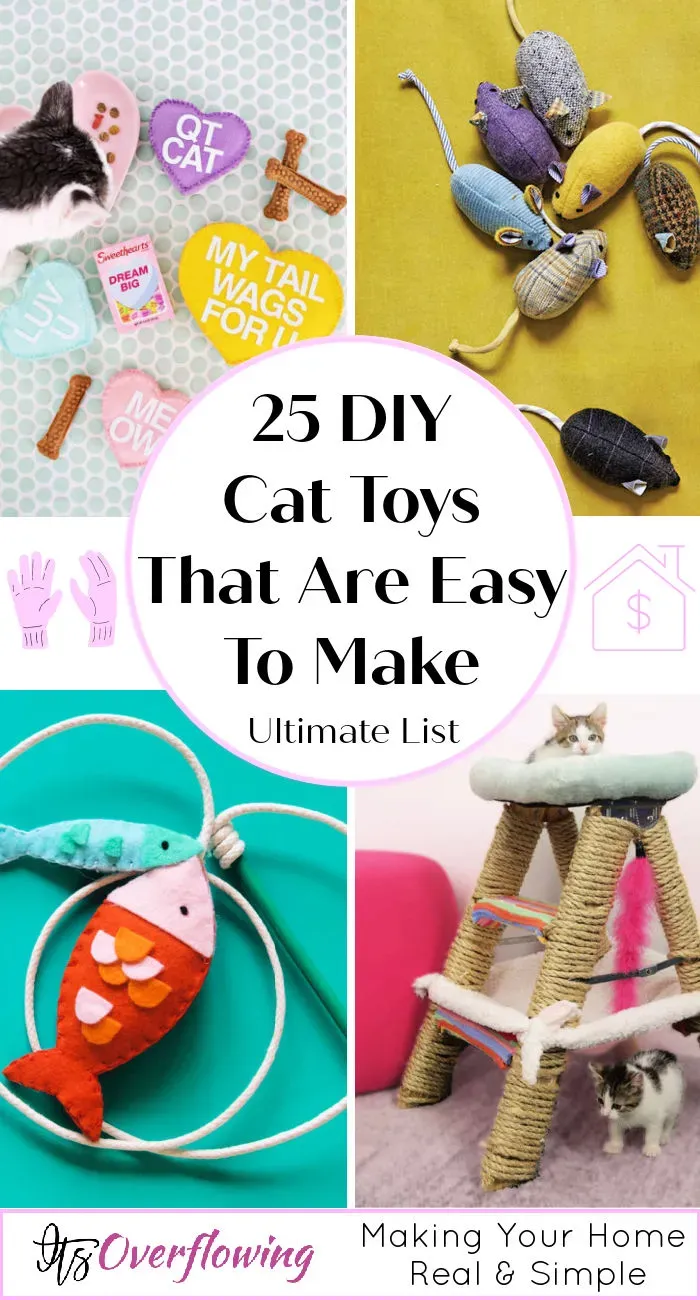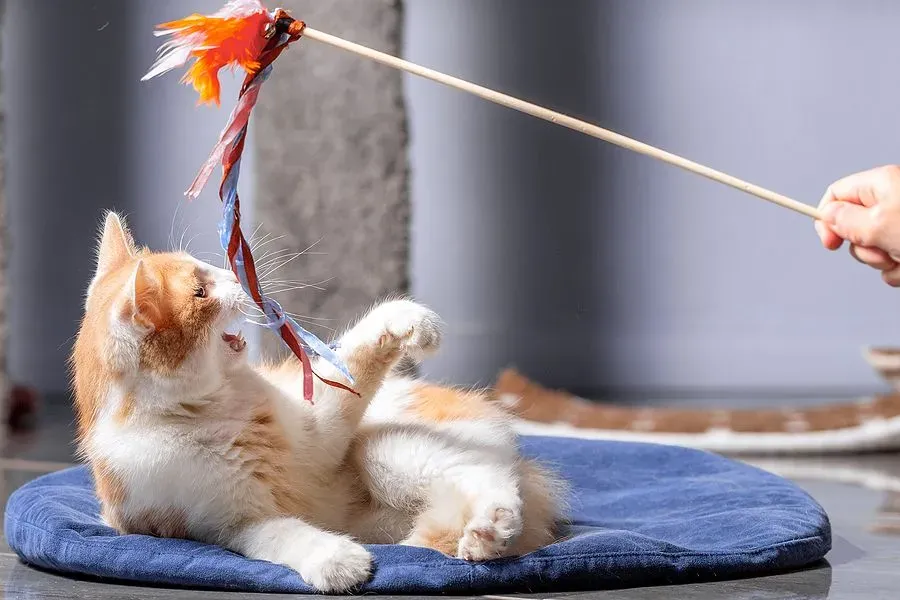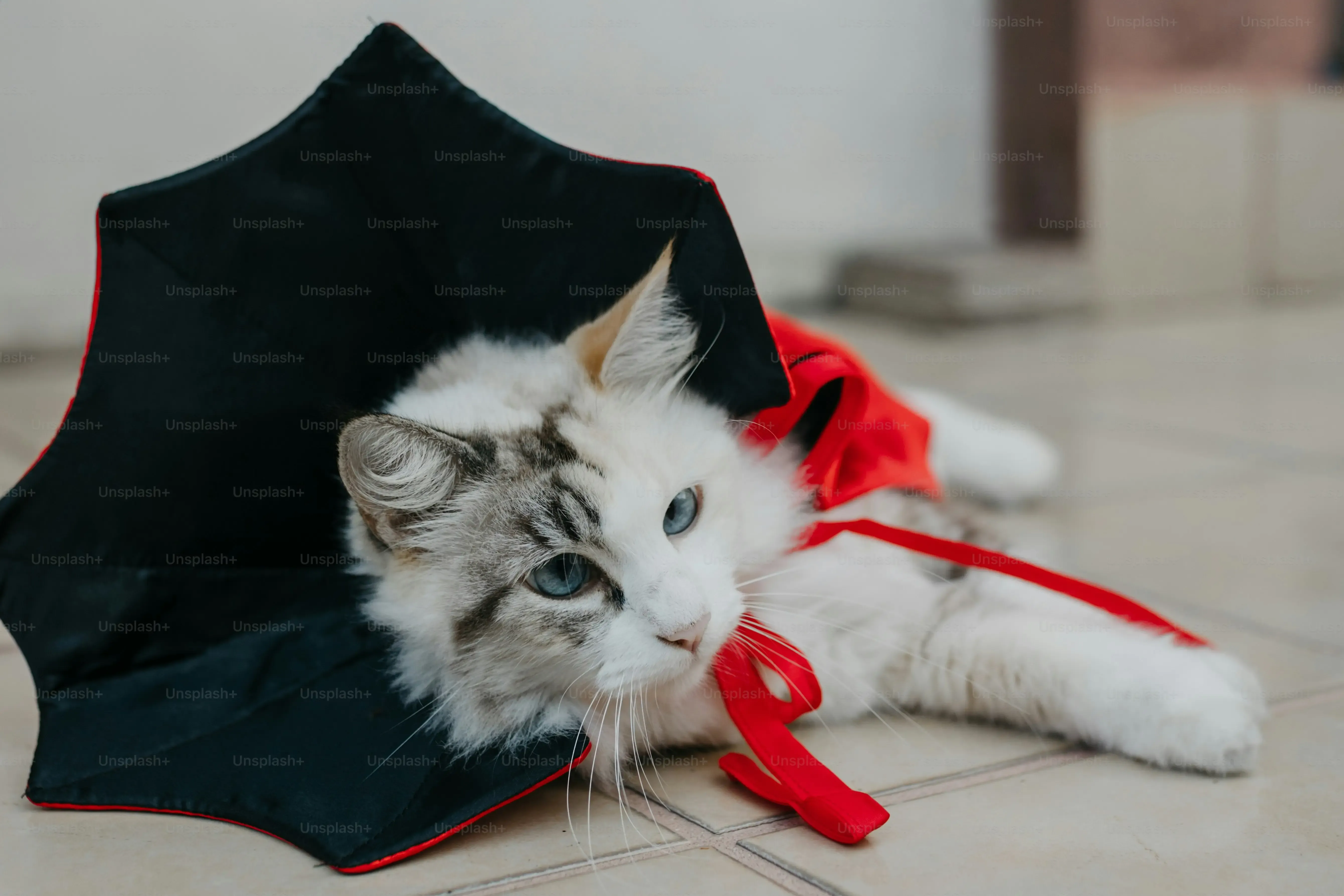Table of Contents
Let's be honest, cats are adorable little chaos agents who seem to find more fun in a discarded cardboard box than that fancy, laser-activated toy you just dropped fifty bucks on. Sound familiar? You're not alone. The aisle of brightly colored, crinkle-stuffed feline entertainment can feel like a financial black hole, and often, the novelty wears off faster than you can say "catnip." Plus, all that plastic adds up. Maybe you've got a perpetually bored tabby staring accusingly at you, or perhaps you're just tired of funding the pet store's yacht. Whatever the reason, you've landed here because you're considering a different path: the wonderful world of the homemade cat toy.
Why Bother with Homemade Cat Toys Anyway?

Why Bother with Homemade Cat Toys Anyway?
Look, I get it.
You see those shelves overflowing with plush mice and feathered wands, and the thought of actually *making* a homemade cat toy seems like an unnecessary chore.
Why add another task to your already overflowing list?
Well, let's talk reality for a second.
Your cat likely cycles through store-bought toys faster than you cycle through streaming subscriptions.
That expensive crinkle tunnel? Ignored after a day.
The interactive laser pointer? Only interesting until it stops moving.
Making a homemade cat toy isn't just about saving a few bucks (though that's a nice perk, especially when you see the price tags on some of this stuff).
It's about giving your cat something novel, something that often appeals to their natural instincts in a way mass-produced plastic just can't replicate.
It's also about reusing materials you already have, which feels pretty good in a world drowning in discarded everything.
Plus, there's a weird satisfaction in watching your cat go absolutely bonkers over a simple cardboard roll or a sock stuffed with catnip.
Why pay for something they'll ignore when you can create their new favorite obsession for free?
Simple Homemade Cat Toy Ideas You Can Craft Right Now

Simple Homemade Cat Toy Ideas You Can Craft Right Now
The Mighty Cardboard Roll and Other Wonders
let's start with the absolute basics. Like, "you probably have this in your recycling bin right now" basics. The humble toilet paper or paper towel roll is a feline goldmine. Seriously. You can just give it to them as is – many cats love batting it around, chasing it, or even trying to shred it (supervised, of course). For a tiny upgrade on this ultimate simple homemade cat toy, fold in the ends to make a little tube. Pop a few dry kibbles or treats inside. Now you've got a puzzle toy! They have to roll it around to get the goodies out. It’s cheap, it’s effective, and it keeps their brains busy. Another quick win? A paper bag (handles cut off for safety!). Most cats can't resist the crinkle and the hiding spot. Just toss one on the floor and watch the fun unfold.
Socks, Shirts, and String (Use with Caution!)
Dig through that pile of single socks you've been ignoring. Find one that's seen better days. Stuff it with some old t-shirt scraps or even dried beans for a fun rattle sound. Tie it off securely. Boom. Instant mouse proxy. If you happen to have some catnip (dried or spray), a little sprinkle inside that sock will make it irresistible. Old t-shirts themselves can be cut into strips and braided or knotted into simple pull toys. Just make sure there are no small pieces that can be chewed off and swallowed. A simple length of sturdy twine or yarn can provide endless entertainment as you wiggle it under a blanket, mimicking prey. Always supervise string play, though, as swallowing string is seriously dangerous for cats. These simple homemade cat toys leverage items you'd otherwise discard.
- Toilet paper rolls (empty or with treats inside)
- Paper bags (handles removed)
- Lone socks stuffed with fabric scraps
- Braided t-shirt strips
- Sturdy string or twine (supervised play only!)
The Magic of the Bottle Cap and Cork
Ever notice how cats are fascinated by tiny things that skitter across the floor? Bottle caps are perfect for this. A plastic water bottle cap, flicked across a hard surface, will send most cats into immediate hunting mode. They love to chase, bat, and carry them. Just make sure they aren't the type of cat that tries to *eat* plastic caps – supervision is key. Wine corks are another fantastic, often overlooked, option for a simple homemade cat toy. Their texture is appealing, they're lightweight for batting, and they bounce unpredictably. You can even poke a hole through a cork and thread a feather or a piece of yarn through it to make it even more enticing. These small items provide big entertainment for your feline friend.
Level Up: More Creative Homemade Cat Toy Projects

Level Up: More Creative Homemade Cat Toy Projects
Felt Mice and Fabric Fun
Alright, so you've mastered the toilet paper roll and the sock mouse. Ready to dip your toes into something that feels a *little* more like crafting but is still totally doable? Think felt. Felt is forgiving, doesn't fray much, and comes in fun colors. You can cut out simple mouse shapes, stitch two pieces together (a running stitch is fine, nobody's judging your sewing skills), and stuff them with a bit of polyfill or, ideally, some dried catnip. Add a felt tail or a piece of sturdy twine. That's it. A custom, soft, and potentially mind-altering mouse for your furball. Old t-shirts can also be cut into squares, filled, and tied off like little pouches. Easy peasy, and you're repurposing textiles.
Cardboard Castles and Puzzle Feeders
Remember those cardboard boxes? They're not just for sitting in. With a little tape and scissors, you can build multi-level cat forts or simple tunnels. Cut various sized holes for entry and exit. Your cat gets a new exploration zone, and you get a temporary piece of architectural absurdity in your living room. For a step up in the puzzle department beyond the basic tube, grab a shoebox or a small cardboard delivery box. Cut holes in the lid or sides that are just big enough for your cat to get a paw into, but not so big they can just dump everything out. Toss some treats or kibble inside. They have to work to get the food out, engaging their problem-solving skills (or just sheer, brute force). It's like dinner and a game show.
- Felt scraps
- Needle and thread or fabric glue
- Polyfill or catnip for stuffing
- Old t-shirts or fabric
- Cardboard boxes (shoeboxes, delivery boxes)
- Packing tape
- Scissors or utility knife
- Dry kibble or treats
Feathers, Wands, and Danglers
Cats are hardwired to hunt things that flutter and dart. This is where feather toys come in. You can buy craft feathers relatively cheaply. The trick is attaching them securely to something safe. A sturdy dowel rod or even a thick, smooth stick from the yard can become the base of a DIY wand toy. Drill a small hole in one end, thread strong twine or wire through it, and attach a cluster of feathers, felt shapes, or even a cork at the end. Use strong glue (non-toxic when dry!) or wrap the attachment point with tape and then cover it with fabric for extra security. Always put wand toys away when you're not actively supervising play; the string or wire can be a serious hazard if chewed or swallowed. Crafting a homemade cat toy that mimics prey movement is guaranteed to get their attention.
Don't Forget Safety: Making Your Homemade Cat Toys CatProof

Don't Forget Safety: Making Your Homemade Cat Toys CatProof
Check Your Materials Like a Hawk
so you've got a pile of potential homemade cat toy ingredients. That's great! But before you unleash your creations on your unsuspecting furball, you need to play quality control. Think like a cat trying to destroy something. Are there small buttons, beads, or googly eyes that could be chewed off and swallowed? Cats aren't known for their careful chewing; they're built to rip and tear. Anything tiny that detaches is a choking hazard or, worse, can cause a blockage in their digestive system requiring expensive and invasive surgery. Avoid anything brittle that can splinter. Even seemingly innocuous things like pipe cleaners can be dangerous if a cat chews off the sharp wire inside. Stick to sturdy fabrics, securely attached feathers, and large, non-toxic items.
The Silent Danger of String and Linear Objects
This is arguably the biggest safety rule when it comes to homemade cat toys, especially anything involving yarn, string, ribbon, or even long pieces of fabric or tinsel. Cats' tongues have tiny barbs that point backward. This is great for grooming but terrible if they start swallowing a string. They can't easily spit it out, and it just keeps getting pulled in. Once swallowed, linear objects can bunch up the intestines like an accordion, cutting off blood supply and causing severe damage. Always, always, always supervise playtime with string toys. And put them away – completely out of reach – when you're done. Don't leave a yarn ball sitting out, no matter how cute it looks. It's a risk not worth taking.
- Avoid small, detachable parts (buttons, beads, eyes).
- Ensure any stuffing is non-toxic if ingested.
- Never leave cats unsupervised with string, yarn, ribbon, or tinsel.
- Check toys regularly for wear and tear.
- Use non-toxic glues and paints, ensuring they are fully dry.
- Avoid anything brittle that can splinter.
Inspect and Supervise, It's Your Job
Making a homemade cat toy is just the first step. Your responsibility continues every time your cat plays with it. Get into the habit of doing a quick safety check before playtime. Look for loose threads, tears in the fabric, or parts that are starting to come undone. If a toy looks like it's seen better days or is starting to fall apart, it's time to retire it. Don't try to get one last play session out of it; that's when accidents happen. And as mentioned with string, active supervision is key for certain types of toys. Watch how your cat interacts with the toy. Are they just batting it around, or are they trying to chew pieces off? Tailor the toys you offer to your cat's individual play style and chewing habits. Not every cat is suited for every type of toy, homemade or store-bought.
Your Cat's Next Favorite Toy is Probably Trash
Look, nobody's saying you have to quit your day job and open an Etsy shop for toilet paper roll mice. But hopefully, this has shown you that keeping your cat entertained doesn't require a second mortgage. A crumpled piece of paper, a sock tied in a knot, or a box with a hole cut in it can often provide more genuine amusement than the latest battery-operated gadget. You save money, you reduce waste, and you get to see your cat's particular brand of joy when they discover something new (or old) to bat around. Just remember to keep an eye on things and make sure whatever you craft is sturdy and doesn't have bits they can swallow. So go ahead, rummage through that recycling bin. Your cat is probably already judging your procrastination.